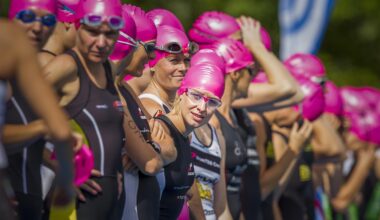Assessing Performance Gains Post High Altitude Training
High altitude training has gained significant attention in the world of sports science for its potential to enhance athletic performance. Athletes often seek the unique environmental conditions found at higher elevations to improve oxygen efficiency in their bodies. This training is based on the concept of hypoxia, where the lower levels of oxygen stimulate physiological adaptations. These adaptations can lead to improved endurance and strength when athletes return to sea level. For instance, critical adaptations include increased red blood cell production and enhanced aerobic capacity. Additionally, this method can reduce the risk of injuries by allowing athletes to enjoy different training modalities. It builds mental toughness and offers a competitive advantage. However, the altitude training method must be monitored to prevent health issues. It is essential to consider the duration of exposure and the altitude used. Moreover, nutrition and hydration strategies play a critical role in maximizing the benefits of high altitude training. So, while this training strategy offers numerous potential gains, careful planning is needed to maximize the outcomes and minimize potential downsides associated with altitude training while ensuring optimal athletic performance.
Research indicates that the performance gains achieved through high altitude training differ among individuals. Factors such as genetics, fitness level, and the specific altitude at which the training occurs play a significant role in determining outcomes. Some athletes may experience notable improvements in VO2 max, leading to increased endurance and performance in their respective sports. In contrast, others might see minimal gains, highlighting the variability in response to such training regimens. The physiological adaptations that occur can be influenced by the intensity and duration of training at altitude. Training programs should be tailored to meet the unique needs of each athlete to achieve optimal results. Seasoned coaches and sports scientists recommend a combination of altitude training and sea-level training. This approach allows athletes to capitalize on the benefits while still maintaining performance levels. While some researchers advocate for continued studies to quantify specific performance indicators, the consensus remains that altitude training can significantly enhance athletic prowess. Athletes who engage in this training method should remain aware of their individual responses and carefully monitor their performance metrics throughout the process.
Physiological Adaptations from High Altitude Training
The physiological adaptations resulting from high altitude training are diverse and significantly impact an athlete’s performance. As athletes expose their bodies to low oxygen environments, the body responds by producing more erythropoietin, which stimulates red blood cell production. Consequently, this increase in red blood cells improves the oxygen transport system in the bloodstream. Enhanced oxygen delivery can result in substantial gains in aerobic performance. Additionally, high altitude training encourages skeletal muscle adaptations, such as increased capillary density and mitochondrial efficiency. These changes ultimately improve an athlete’s ability to process and utilize oxygen during strenuous exercises. The adaptations don’t occur instantaneously; a well-structured training plan over multiple weeks is essential to maximize these physiological changes. Coaches and athletes should work together to adjust training intensity and volume based on individual responses to altitude. Furthermore, understanding the balance between training load and recovery is crucial for preventing overtraining and injuries. The synergistic effects of acclimatization and continued training at sea level ensure ongoing performance enhancement and optimal athletic development.
The benefits of high altitude training extend beyond physiological enhancements; they also encompass mental fortitude and strategic advantages. The psychological component of competing at elevated levels can lead to improved confidence and performance under pressure. Athletes often cite the mental challenges posed by altitude as a means of developing resilience and grit. The demanding conditions of training in thinner air force athletes to adapt, instilling a sense of accomplishment upon returning to sea level. Moreover, psychological preparedness can translate into enhanced race-day performances, where athletes feel more capable of handling the rigors of competition. Integrating altitude training into a broader training plan can lead to a holistic improvement in athletes. They not only gain physical enhancements but also cultivate a winning mindset and race-day readiness. Observing competitors and understanding individual limitations allows athletes to develop effective strategies, fundamentally changing their approach to racing. This duality of physical and mental gains positions high altitude training as a valuable tool in the athlete’s arsenal when vying for peak performance. Adapting to challenges both mentally and physically prepares athletes for peak performances in their respective sports.
Monitoring Performance Metrics
Monitoring performance metrics is essential in evaluating the effectiveness of high altitude training. Coaches and sports scientists should implement robust systems that track various indicators. Key performance metrics include VO2 max, lactate threshold, and race times. Regular assessments enable athletes to understand the physiological changes that occur due to altitude training. Furthermore, heart rate and recovery rates are indicators of overall conditioning. Athletes should be familiar with both anaerobic and aerobic performance metrics to maximize training outcomes. Additionally, subjective measures such as perceived exertion and fatigue levels provide crucial insights into an athlete’s response to altitude. Over time, this data can reveal patterns that inform training decisions. Component tracking allows adjustments to training intensity, duration, and recovery strategies. Consequently, sophisticated metrics tracking systems help tailor altitude exposure to each athlete’s needs. This personalized approach ensures maximum efficiency and risk management in training. Ultimately, the insights gathered create a foundation for refined training protocols, which can lead to sustained performance gains. Successful high altitude training is a cumulative process, requiring constant evaluation and adaptation based on data derived from performance metrics.
Recovery plays a pivotal role in realizing the benefits of high altitude training. Athletes must prioritize recovery strategies tailored to the stressors encountered while training at elevation. Strategies might include structured recovery sessions, active rest, and adequate nutrition, focusing on macronutrient balance. Integration of hydration practices is equally essential, as dehydration can hinder the recovery process. Sports scientists recommend monitoring hydration levels to optimize performance and recovery outcomes. Sleep quality is another crucial element in this process. Athletes must recognize the impact of sleep on recovery and performance, particularly after strenuous altitude training sessions. They should aim for restorative sleep patterns conducive to muscle repair and cognitive function. Additionally, the strategic use of massages and physiotherapy can aid in muscle recovery and alleviate soreness post-training. Athletes necessitate a well-rounded recovery plan that efficiently incorporates nutrition, hydration, sleep, and physical therapies. This holistic approach ensures that athletes return to training feeling revitalized and ready for the next challenge. Ultimately, the recovery process serves as an integral component in maximizing the performance gains realized after altitude training.
Implementation Strategies for Athletes
Implementing an effective high altitude training program requires thorough preparation and understanding. Athletes should begin by establishing a clear goal for their training, tailoring their altitude strategy accordingly. This may involve selecting the appropriate altitude and duration based on their current fitness levels. Similarly, they should plan for optimal acclimatization periods to ensure their bodies adapt effectively. Training programs must address peak training volumes and specific exercises that take advantage of the unique environmental conditions. Working closely with coaches allows athletes to adjust intensity levels and ensure safety throughout their training regimen. These adjustments help to facilitate ideal performance gains while minimizing risks. Communication between athletes, coaches, and sports scientists is crucial for successful implementation. Regular reviews of training progress and modifications should be established as a priority. Furthermore, using technology to gather data during training can guide decision-making processes, ensuring efficient training practices. A well-executed program integrates altitude training with other modalities to enhance overall athletic development. Laboratory testing and field assessments provide additional insights that can influence training decisions and positively impact performance outcomes.
In conclusion, high altitude training offers a profound opportunity for athletes seeking to enhance their performance. The physiological adaptations, mental fortitude, and strategic implementation provide a multifaceted approach to training. Athletes who engage in altitude training can witness improved endurance and strength through tailored programs. Understanding the impact of this training style requires taking a comprehensive approach that includes monitoring metrics and employing efficient recovery strategies. The process is not linear, as individual variability necessitates ongoing adaptations. Health considerations and injury risks must remain a priority throughout the training process to ensure safety and sustained progress. Ultimately, the balance between effort at altitude and recovery at sea level creates optimum conditions for realizing performance gains. As sports science continues to evolve, ongoing research into the specific benefits of altitude training will further enhance training methodologies. Athletes must stay abreast of new findings and incorporate them into their practices to maximize their competitive advantages. With each athlete’s unique adaptation process, it is crucial to develop personalized training plans in the pursuit of peak performance outcomes through high altitude conditioning.


